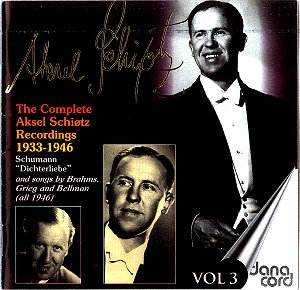Once again I refer readers to my
review of Vol. 1 of this series for brief biographical notes on
Aksel Schiøtz. Vol. 3 completes the series of recordings he made
in London immediately after the war, accompanied by Gerald Moore and
produced by Walter Legge.
Although only a few months had passed since the recording
of Die schöne Müllerin, the voice has greater presence
and the piano sound more bloom. It is really remarkably good for its
age. The sheer luminous beauty and loving care of Moore’s playing would
be an inspiration to any singer. Schiøtz impresses, as ever,
for the ease of his delivery, the words and the vocal line apparently
at one, and for the musicality of his phrasing. Ich grolle nicht
is not rushed off its feet and there is everywhere the impression
that the deepest consideration has been transformed into the purest
feeling. I realise these are generalised words; it is so much easier
to give chapter and verse when things are wrong. However, a previously
unpublished version of this cycle with Folmer Jensen dating from 1942
is included in Vol. 8 so I hope to have the chance to make closer comparisons
in due course, and perhaps to gain some inkling as to why this
version seems so perfect.
The booklet prints Schiøtz’s own notes on performing
the cycle, written in 1970. At times this sort of thing can be embarrassing
– so many performers write one thing and do another. But Schiøtz
practices what he preaches, and so his notes make an illuminating supplement
to the performance itself. When the world is rather full of singers
who think that a song really begins when they start singing and
finishes with their last note, let us hear what Schiøtz
has to say about the postlude: "The beautiful and expressive piano
postlude recalls the mood of previous songs. It encompasses all the
misery and poetic love of Dichterliebe. The singer should try
to relive all the emotions he has been trying to express in these sixteen
gems of song, and he should stand still while he listens, together
with his audience, to the postlude".
I commented on the earlier discs that occasional hints
– a few strained high notes – could be heard of the tumour that was
growing in Schiøtz’s vocal chords. Although these 1946 recordings
were made closer still to the operation which effectively ended his
singing career, I have to say I found the voice in consistently good
form. My other reservation, regarding his use from time to time of a
downward portamento, is still present but worries me less in this more
romantic music. So here is a precious document indeed.
Walter Legge had plenty of projects lined up for Schiøtz,
including much Brahms, whose songs were very poorly represented in the
catalogues then. Alas, all there was time for were these three; a wonderfully
controlled Mainacht, pervaded by the calmness of the warm May
night, an upfront, cholesterol-free Sonntag and a Ständchen
which, though light and humorous, is not too fast to let us hear
the words. And three more Grieg (5 from 1943 were included in Vol. 2).
The two from op. 49 are wonderful songs, Grieg at his richest with piano
parts that look ahead to Debussy. While in A Poet’s last song Schiøtz’s
caressing rubato elevates a piece which could well sound four-square
and banal.
Carl Michael Bellmann was a poet and composer (most
of the melodies are actually folk tunes, and they all sound as if they
are) whose low-life portraits may seem a musical equivalent of Hogarth’s
work in London or the genre painting in nearby Holland. Whether his
work is quite rich enough, judged purely as music, for a non-Swedish
listener to take the trouble to study the translations (which are provided;
Danacord as always give a lesson in presentation to certain major companies)
and therefore appreciate the interaction of words and music, I rather
doubt. Schiøtz must have been fond of them, for earlier versions
of two of these pieces, and of several others, appear in Vol. 5. Even
without knowing a word of Swedish I can detect the clarity of diction
– speech-rhythm and musical rhythm seemingly as one – for which he was
famed.
Considering how attractive Buxtehude can be, I thought
this little cantata a relatively routine piece but, with Mogens Wöldike
at the helm, it gets a performance which stylistically sounds fairly
acceptable even today.
I hope I have made it clear that the lieder on this
CD are absolutely essential listening for all who care about Schumann,
Brahms and the singer’s art.
Christopher Howell

